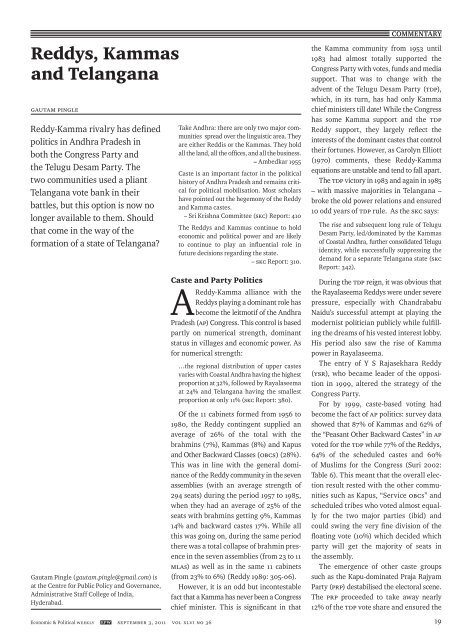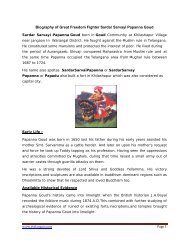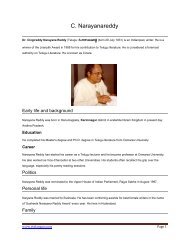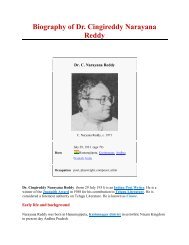Reddys, Kammas and Telangana
Reddys, Kammas and Telangana
Reddys, Kammas and Telangana
You also want an ePaper? Increase the reach of your titles
YUMPU automatically turns print PDFs into web optimized ePapers that Google loves.
<strong>Reddys</strong>, <strong>Kammas</strong><br />
<strong>and</strong> <strong>Telangana</strong><br />
Gautam Pingle<br />
Reddy-Kamma rivalry has defined<br />
politics in Andhra Pradesh in<br />
both the Congress Party <strong>and</strong><br />
the Telugu Desam Party. The<br />
two communities used a pliant<br />
<strong>Telangana</strong> vote bank in their<br />
battles, but this option is now no<br />
longer available to them. Should<br />
that come in the way of the<br />
formation of a state of <strong>Telangana</strong>?<br />
Gautam Pingle (gautam.pingle@gmail.com) is<br />
at the Centre for Public Policy <strong>and</strong> Governance,<br />
Administrative Staff College of India,<br />
Hyderabad.<br />
Take Andhra: there are only two major communities<br />
spread over the linguistic area. They<br />
are either Reddis or the <strong>Kammas</strong>. They hold<br />
all the l<strong>and</strong>, all the offices, <strong>and</strong> all the business.<br />
– Ambedkar 1955<br />
Caste is an important factor in the political<br />
history of Andhra Pradesh <strong>and</strong> remains critical<br />
for political mobilisation. Most scholars<br />
have pointed out the hegemony of the Reddy<br />
<strong>and</strong> Kamma castes.<br />
– Sri Krishna Committee (SKC) Report: 410<br />
The <strong>Reddys</strong> <strong>and</strong> <strong>Kammas</strong> continue to hold<br />
economic <strong>and</strong> political power <strong>and</strong> are likely<br />
to continue to play an influential role in<br />
future decisions regarding the state.<br />
– SKC Report: 310.<br />
Caste <strong>and</strong> Party Politics<br />
A<br />
Reddy-Kamma alliance with the<br />
<strong>Reddys</strong> playing a dominant role has<br />
bec0me the leitmotif of the Andhra<br />
Pradesh (AP) Congress. This control is based<br />
partly on numerical strength, dominant<br />
status in villages <strong>and</strong> economic power. As<br />
for numerical strength:<br />
…the regional distribution of upper castes<br />
varies with Coastal Andhra having the highest<br />
proportion at 32%, followed by Rayalaseema<br />
at 24% <strong>and</strong> <strong>Telangana</strong> having the smallest<br />
proportion at only 11% (SKC Report: 380).<br />
Of the 11 cabinets formed from 1956 to<br />
1980, the Reddy contingent supplied an<br />
average of 26% of the total with the<br />
brahmins (7%), <strong>Kammas</strong> (8%) <strong>and</strong> Kapus<br />
<strong>and</strong> Other Backward Classes (OBCs) (28%).<br />
This was in line with the general dominance<br />
of the Reddy community in the seven<br />
assemblies (with an average strength of<br />
294 seats) during the period 1957 to 1985,<br />
when they had an average of 25% of the<br />
seats with brahmins getting 9%, <strong>Kammas</strong><br />
14% <strong>and</strong> backward castes 17%. While all<br />
this was going on, during the same period<br />
there was a total collapse of brahmin presence<br />
in the seven assemblies (from 23 to 11<br />
MLAs) as well as in the same 11 cabinets<br />
(from 23% to 6%) (Reddy 1989: 305-06).<br />
However, it is an odd but incontestable<br />
fact that a Kamma has never been a Congress<br />
chief minister. This is significant in that<br />
COMMENTARY<br />
the Kamma community from 1953 until<br />
1983 had almost totally supported the<br />
Congress Party with votes, funds <strong>and</strong> media<br />
support. That was to change with the<br />
advent of the Telugu Desam Party (TDP),<br />
which, in its turn, has had only Kamma<br />
chief ministers till date! While the Congress<br />
has some Kamma support <strong>and</strong> the TDP<br />
Reddy support, they largely reflect the<br />
interests of the dominant castes that control<br />
their fortunes. However, as Carolyn Elliott<br />
(1970) comments, these Reddy-Kamma<br />
equations are unstable <strong>and</strong> tend to fall apart.<br />
The TDP victory in 1983 <strong>and</strong> again in 1985<br />
– with massive majorities in <strong>Telangana</strong> –<br />
broke the old power relations <strong>and</strong> ensured<br />
10 odd years of TDP rule. As the SKC says:<br />
The rise <strong>and</strong> subsequent long rule of Telugu<br />
Desam Party, led/dominated by the <strong>Kammas</strong><br />
of Coastal Andhra, further consolidated Telugu<br />
identity, while successfully suppressing the<br />
dem<strong>and</strong> for a separate <strong>Telangana</strong> state (SKC<br />
Report: 342).<br />
During the TDP reign, it was obvious that<br />
the Rayalaseema <strong>Reddys</strong> were under severe<br />
pressure, especially with Ch<strong>and</strong>rababu<br />
Naidu’s successful attempt at playing the<br />
modernist politician publicly while fulfilling<br />
the dreams of his vested interest lobby.<br />
His period also saw the rise of Kamma<br />
power in Rayalaseema.<br />
The entry of Y S Rajasekhara Reddy<br />
(YSR), who became leader of the opposition<br />
in 1999, altered the strategy of the<br />
Congress Party.<br />
For by 1999, caste-based voting had<br />
become the fact of AP politics: survey data<br />
showed that 87% of <strong>Kammas</strong> <strong>and</strong> 62% of<br />
the “Peasant Other Backward Castes” in AP<br />
voted for the TDP while 77% of the <strong>Reddys</strong>,<br />
64% of the scheduled castes <strong>and</strong> 60%<br />
of Muslims for the Congress (Suri 2002:<br />
Table 6). This meant that the overall election<br />
result rested with the other communities<br />
such as Kapus, “Service OBCs” <strong>and</strong><br />
scheduled tribes who voted almost equally<br />
for the two major parties (ibid) <strong>and</strong><br />
could swing the very fine division of the<br />
floating vote (10%) which decided which<br />
party will get the majority of seats in<br />
the assembly.<br />
The emergence of other caste groups<br />
such as the Kapu-dominated Praja Rajyam<br />
Party (PRP) destabilised the electoral scene.<br />
The PRP proceeded to take away nearly<br />
12% of the TDP vote share <strong>and</strong> ensured the<br />
Economic & Political Weekly EPW september 3, 2011 vol xlvi no 36 19
COMMENTARY<br />
victory for the second time of the Congress<br />
Party <strong>and</strong> YSR. 1<br />
However, the re-emergence of the<br />
<strong>Telangana</strong> movement as a major mass movement<br />
meant that the equations within the<br />
Congress Party <strong>and</strong> the state – now dominated<br />
by YSR <strong>and</strong> the Rayalaseema <strong>Reddys</strong><br />
– had to be addressed. YSR <strong>and</strong> the Congress<br />
had backed the movement as a way of<br />
enticing the <strong>Telangana</strong> voters away from the<br />
TDP <strong>and</strong> this worked well for the party in<br />
2004 <strong>and</strong> 2009. For the dominant castes in<br />
<strong>Telangana</strong> – <strong>Reddys</strong> <strong>and</strong> Velmas – had been<br />
forced by the strength of the movement to<br />
fall in line with the separate statehood dem<strong>and</strong>.<br />
This was commented on by the SKC:<br />
20<br />
The <strong>Telangana</strong> upper castes have thrown in<br />
their lot with the rest of the region in their<br />
dem<strong>and</strong> for separate <strong>Telangana</strong> as they see<br />
greater political <strong>and</strong> economic opportunities<br />
for themselves in a separate state. The leadership<br />
of the movement remains with the upper<br />
caste while the mass following is provided<br />
by the SCs <strong>and</strong> OBCs (SKC Report: 380).<br />
YSR could hardly afford to lose the newly<br />
acquired base in <strong>Telangana</strong> by conceding<br />
what he <strong>and</strong> the high comm<strong>and</strong> promised<br />
<strong>Telangana</strong> Rashtra Samithi (TRS) <strong>and</strong> the<br />
all voters in Andhra Pradesh – a separate<br />
<strong>Telangana</strong> state. It may not have mattered<br />
to the Congress high comm<strong>and</strong> or the party<br />
but it mattered a lot to the Rayalaseema<br />
Reddy faction <strong>and</strong> their control of the state<br />
Congress Party <strong>and</strong> government. So the<br />
policy of “delay <strong>and</strong> deceive” was implemented.<br />
However all this unravelled with<br />
YSR’s death <strong>and</strong> the dem<strong>and</strong> of his large<br />
faction to make his young son Jaganmohan<br />
Reddy chief minister – a dem<strong>and</strong> not conceded<br />
by the high comm<strong>and</strong> of the Congress<br />
Party. By late 2009, the high comm<strong>and</strong><br />
strategy in this context seems to be aimed<br />
at conceding <strong>Telangana</strong> statehood as a way<br />
of breaking the YSR faction.<br />
<strong>Telangana</strong> Statehood<br />
Under the guidance of the Congress high<br />
comm<strong>and</strong>, the political parties in the<br />
state agreed to a separate <strong>Telangana</strong> on<br />
6 December 2009, <strong>and</strong> the union government<br />
agreed formally on 9 December 2009<br />
<strong>and</strong> announced the decision to both houses<br />
of Parliament. After protests from Coastal<br />
Andhra <strong>and</strong> Rayalaseema regions this was<br />
followed by an attempt to divert the process<br />
by appointing the Sri Krishna Committee.<br />
Its report did nothing to sort out the issue but<br />
on the other h<strong>and</strong> exposed the real agenda<br />
– to assist in reversing the <strong>Telangana</strong><br />
statehood decision.<br />
The recent resignations of 101 members<br />
of the assembly including nine ministers <strong>and</strong><br />
10 members of Parliament – all from <strong>Telangana</strong><br />
– have caused a national sensation <strong>and</strong><br />
threatens to destabilise the Congress governments<br />
both in Andhra Pradesh <strong>and</strong> in<br />
New Delhi – especially as the United Progressive<br />
Alliance (UPA) government at the centre<br />
is shaky in the Lok Sabha. The crisis is now<br />
acute <strong>and</strong> needs to be solved.<br />
The <strong>Telangana</strong> statehood issue has acted<br />
to unravel the caste-party politics in Andhra<br />
Pradesh. Despite the Reddy-dominated<br />
Congress Party <strong>and</strong> the Kamma-dominated<br />
TDP, the caste equations were relatively<br />
stable even if adversarial. The SKC comments<br />
very astutely on this issue:<br />
The accommodation between these two regions<br />
has been in terms of political domination<br />
by Rayalaseema <strong>and</strong> economic domination<br />
by Coastal Andhra. Together the two<br />
regions have ruled the state through Congress<br />
<strong>and</strong> TDP political formations. <strong>Telangana</strong><br />
feels dominated by the upper castes of these<br />
regions <strong>and</strong> its struggle is primarily to shake<br />
off their yoke (SKC Report: 390).<br />
The SKC too expected that <strong>Telangana</strong><br />
statehood would provoke the move for a<br />
separate Rayalaseema state: “The agitation<br />
for separation of Rayalaseema from<br />
Coastal Andhra may also start taking<br />
shape sooner than expected” (ibid: 451). It<br />
added for good measure: “The other combination<br />
of regions – Coastal Andhra <strong>and</strong><br />
Rayalaseema together can also sustain<br />
themselves as a state; in fact they can also<br />
sustain themselves separately” (ibid: 121).<br />
Kamma Anxieties<br />
The collapse of the TDP <strong>and</strong> the rise of the<br />
<strong>Telangana</strong> movement brought a deep sense<br />
of concern to the Kamma notables in the<br />
Congress Party. They were reasonably<br />
happy with the TDP as they had their<br />
caste-based connections to its top leadership<br />
but YSR had sidelined them totally in<br />
their own party. With his death <strong>and</strong> the<br />
inevitability of the <strong>Telangana</strong> statehood,<br />
their latent anger burst forth.<br />
Things had gone to the extent that the<br />
veteran Guntur Congress MP Rayapati Sambasiva<br />
Rao is quoted in the press as saying:<br />
<strong>Kammas</strong> like me, my family, Eluru MP Kavuri<br />
Sambasiva Rao, Vijayawada MP Lagadapati<br />
Rajagopal, Renuka Choudhary, have ceaselessly<br />
toiled for the party. Yet, <strong>Reddys</strong> <strong>and</strong><br />
others tell the high comm<strong>and</strong> not to give any<br />
posts to <strong>Kammas</strong>. I spend nearly Rs 15 crore<br />
in every election. But what is the use as our<br />
services are not being recognised (Times of<br />
India 2010).<br />
This then indicated that the powerful<br />
Coastal <strong>Kammas</strong> would perhaps be happy<br />
to have their own state where they could<br />
get rid of the Reddy domination of the<br />
Congress Party.<br />
Rayalaseema Reddy Concerns<br />
The Rayalaseema <strong>Reddys</strong> naturally are<br />
apprehensive that they will be unable to<br />
cope with the Kamma economic clout.<br />
The Rayalaseema Rashtra Samithi (RRS)<br />
president Kuncham Venkata Subba Reddy<br />
asked the UPA government to carve out<br />
Greater Rayalaseema before conceding<br />
the dem<strong>and</strong> for statehood to the <strong>Telangana</strong><br />
region. His idea of Greater Rayalaseema<br />
included Kadapa, Kurnool, Anantapur <strong>and</strong><br />
Chittoor in Rayalaseema region, Vellore<br />
<strong>and</strong> Krishnagiri districts in Tamil Nadu<br />
<strong>and</strong> Raichur, Bellary <strong>and</strong> Kolar districts in<br />
Karnataka (The Hindu 2010). A l<strong>and</strong> grab<br />
of quite a proportion!<br />
Kotla Jaya Surya Prakash Reddy, son<br />
of a former chief minister <strong>and</strong> member<br />
of Lok Sabha from Kurnool is quoted<br />
as saying:<br />
Our first preference is that the State remains<br />
unified. But if it is to be divided into two,<br />
then we do not want to stay with Andhra.<br />
We want a trifurcation <strong>and</strong> a separate state –<br />
Greater Rayalaseema (Deccan Herald 2009)<br />
During the Telugu Desam <strong>and</strong> YSR regimes,<br />
a concerted grab of l<strong>and</strong> in <strong>and</strong><br />
around Hyderabad <strong>and</strong> Ranga Reddy districts<br />
had taken place of largely government<br />
l<strong>and</strong>s or l<strong>and</strong>s whose title was uncertain<br />
as they had earlier belonged to the<br />
Nizam’s sarf e khas (private estate), the<br />
Crown l<strong>and</strong>s, Paigah properties <strong>and</strong> Wakf<br />
Board assets.<br />
SKC comments:<br />
A number of transactions may not be formal<br />
<strong>and</strong> registered. Another aspect of Hyderabad’s<br />
real estate industry is the formal linkage to<br />
political leadership, often from other regions<br />
in Andhra Pradesh. For example, LANCO, an<br />
infrastructure <strong>and</strong> real estate company is<br />
associated with Lagadapati Rajagopal, an MP<br />
from Vijayawada; the Gayatri Construction firm<br />
is associated with T Subbirami Reddy, a former<br />
MP from Visakhapatnam; <strong>and</strong> Transstroy, a<br />
september 3, 2011 vol xlvi no 36 EPW Economic & Political Weekly
firm involved in building the Outer Ring<br />
Road, is associated with Rayapati Sambasiva<br />
Rao, the MP from Guntur (ibid: 319).<br />
Politically powerful <strong>Kammas</strong> <strong>and</strong> <strong>Reddys</strong><br />
shared the major “projects” among themselves<br />
with a lot more other bit players<br />
from Coastal Andhra <strong>and</strong> Rayalaseema<br />
picking up the rest (India Today 2011).<br />
This is the real fear of these vested interests<br />
now vociferously opposing <strong>Telangana</strong><br />
statehood (or at least with Hyderabad<br />
a part of <strong>Telangana</strong>) – that they may<br />
be divested of their ill-gotten l<strong>and</strong>s in <strong>and</strong><br />
around Hyderabad.<br />
Possible Outcomes<br />
Whatever the obstacles laid before it, the<br />
<strong>Telangana</strong> movement has got a life of its<br />
own <strong>and</strong> now dominates the villages with<br />
a popular base <strong>and</strong> there is nothing any<br />
politicians can do about it. Yet even after<br />
the process for statehood was completed<br />
by the Government of India, the awareness<br />
that without the <strong>Telangana</strong> vote bank,<br />
Coastal <strong>Kammas</strong> <strong>and</strong> Rayalaseema <strong>Reddys</strong><br />
would have to slog it out one-to-one makes<br />
all the non-<strong>Telangana</strong> politicians reluctant<br />
to give up on their hitherto compliant <strong>and</strong><br />
tame <strong>Telangana</strong> vote bank.<br />
The only logical <strong>and</strong> political acceptable<br />
solution is to divide the state into three. 2<br />
Then the dominant Kamma <strong>and</strong> Reddy<br />
politicians will each have their own states,<br />
which they can develop them without their<br />
energies being sapped by this ridiculous<br />
caste cold war that they have been waging<br />
for half a century to everyone’s detriment.<br />
Notes<br />
1 It soon merged with the Congress in 2011. Though<br />
it took place after YSR’s death, it is speculated<br />
that this was the logical conclusion of his subtle<br />
moves to consolidate Congress Party power.<br />
2 The viability of the two units – Coastal Andhra<br />
<strong>and</strong> <strong>Telangana</strong> – is good. Rayalaseema may need<br />
assistance. See Pingle (2010).<br />
References<br />
Ambedkar, B R (1955): Thoughts on Linguistic State,<br />
accessed on 23 January 2010, http://www.<br />
ambedkar.org/ambcd/05A.%20Thoughts%20on%<br />
20Linguistic%20States%20Part%20I.htm<br />
Deccan Herald (2009): “Righteous Cause: Greater Rayalaseema”,<br />
http://www.deccanherald.com/content/<br />
41053/righteous-cause-greater-rayalaseema.html<br />
The PDS in Rural Orissa:<br />
Against the Grain?<br />
Ankita Aggarwal<br />
A report from a sample survey of<br />
the functioning of the public<br />
distribution system in 12 villages<br />
in two districts in Orissa, a state<br />
usually associated with a poor PDS.<br />
While there are errors in exclusion<br />
<strong>and</strong> inclusion of households<br />
covered, there has been a vast<br />
improvement in operation of the<br />
PDS; below the poverty line<br />
households seem to be receiving<br />
their entitlements. The households<br />
also express a strong preference<br />
for distribution of grain over cash.<br />
Email: aggarwal.ankita87@gmail.com<br />
In the summer of 2011, we were a part<br />
of a group of about 40 students <strong>and</strong><br />
other young volunteers who set out in<br />
the scorching heat to conduct surveys of<br />
the public distribution system (PDS) across<br />
the country. Amidst growing criticism of<br />
the PDS from policymakers for its high<br />
leakages, <strong>and</strong> calls for replacing it with<br />
cash transfers, we wanted to find out about<br />
the status of PDS on the ground <strong>and</strong> people’s<br />
preferences between food <strong>and</strong> cash.<br />
Our team went to Sundargarh <strong>and</strong><br />
Nuapada districts of Orissa where we<br />
surveyed six villages in each district. True<br />
to its name, Sundargarh is a beautiful<br />
district which has about 43% of its total<br />
area under forest cover. Nuapada is part of<br />
the Kalah<strong>and</strong>i, Bolangir <strong>and</strong> Koraput (KBK)<br />
region, notorious for starvation deaths <strong>and</strong><br />
distress migration. Twelve households were<br />
selected at r<strong>and</strong>om from the BPL list in<br />
COMMENTARY<br />
Elliott, Carolyn M (1970): “Caste <strong>and</strong> Faction among<br />
the Dominant Castes: The <strong>Reddys</strong> <strong>and</strong> <strong>Kammas</strong> of<br />
Andhra” in Rajni Kothari (ed.), Caste <strong>and</strong> Politics<br />
(New Delhi: Orient Longman), pp 129-69.<br />
High Court of Andhra Pradesh, Writ Petition No 1569<br />
of 2011 (M Narayan Reddy vs Government of India,<br />
Home Ministry), Justice L Narasimha Reddy presiding,<br />
Hyderabad, 23 March 2011. http://articles.<br />
timesofindia.indiatimes.com/2010-05-09/hyderabad/28320353_1_rayapati-k-rosaiah-cbi-inquiry,<br />
May 9, accessed 11 August 2011.<br />
India Today (2011): “Andhra Industrialists Turning to<br />
Politics to Protect Their Interests”, http://indiatoday.<br />
intoday.in/site/story/<strong>and</strong>hra-industrialists-turningto-politics-to-protect-their-interests/1/141035.html<br />
Pingle, Gautam (2010): “Trifurcation Would Yield Three<br />
Viable States”, New Indian Express, 24 May<br />
(http://expressbuzz.com/states/<strong>and</strong>hra-pradesh/<br />
trifurcation-would-yield-three-viable-states/175965.<br />
htm), accessed on 5 May 2011.<br />
Reddy, G Ram (1989): “The Politics of Accommodation”<br />
in Francine R Frankel <strong>and</strong> M S A Rao (ed.), Dominance<br />
<strong>and</strong> State Power in Modern India, Volume I<br />
(New Delhi: OUP), pp 265-321.<br />
Sri Krishna Committee (2010): Report of the Committee<br />
for Consultations on the Situation in Andhra<br />
Pradesh (SKC Report), New Delhi, December.<br />
Suri, K C (2002): Democratic Process <strong>and</strong> Electoral Politics<br />
in Andhra Pradesh, Overseas Development Institute,<br />
London, p 85, http://www.odi.org.uk/projects/<br />
00-03-livelihood-options/papers/reportdraft1.doc,<br />
accessed on 23 January 2010.<br />
The Hindu (2010): “Now, Dem<strong>and</strong> for Separate Rayalaseema”,<br />
5 May, accessed 11 August, http://<br />
www.thehindu.com/2010/05/05/stories/2010050556480500.htm<br />
Times of India (2010): “<strong>Kammas</strong> Getting Raw Deal in<br />
Cong: Rayapati”.<br />
each sample village; the 12 sample villages<br />
were also selected at r<strong>and</strong>om – three villages<br />
in each block, two blocks in each<br />
district. In addition, we interviewed the<br />
person running the local PDS outlet.<br />
Ordinarily, all the respondent households<br />
were getting their full quota of rice<br />
– 30 kg per month for BPL <strong>and</strong> 35 kg per<br />
month for Antyodaya cardholders at Rs 2<br />
per kg in both cases. The Government of<br />
Orissa has made PDS universal in the KBK<br />
region, by adding its own resources to the<br />
central allocations. As a result, in Nuapada,<br />
even above the poverty line (APL) households<br />
were entitled to 25 kg per month at<br />
Rs 2 per kg. Since November 2010, BPL<br />
households have been getting an additional<br />
5 kg per month because of a Supreme<br />
Court order directing the government to<br />
distribute excess food stocks.<br />
At most places rice was being distri buted<br />
regularly every month. In Orissa, BPL <strong>and</strong><br />
Antyodaya cardholders are also entitled to<br />
2 kg of sugar every month at Rs 13.5 per kg<br />
<strong>and</strong> four litres of kerosene every month at<br />
Rs 13-14.5 per litre (the price of kerosene<br />
depends on the proximity of the PDS outlet<br />
to the warehouse). Supply of these two<br />
commodities was much more irregular than<br />
Economic & Political Weekly EPW september 3, 2011 vol xlvi no 36 21





